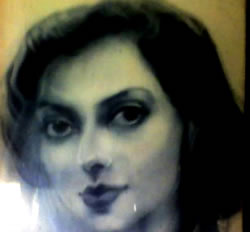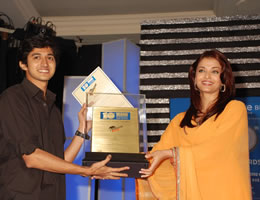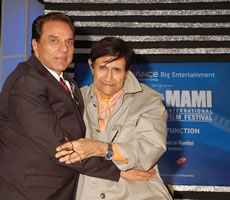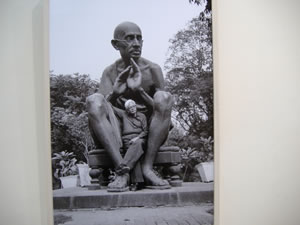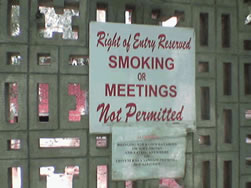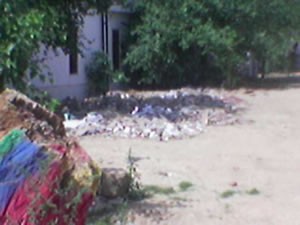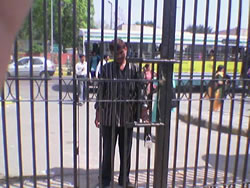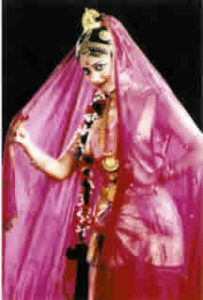
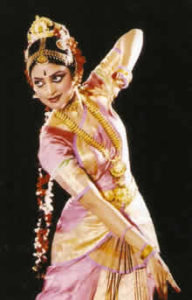
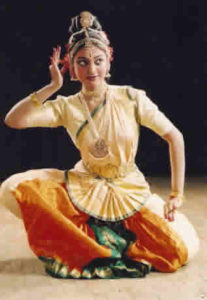
I first saw Arunima dance before a TV camera in Lodhi Gardens. The effortles ease with which she glided through her steps almost simulated levitation. She is one of the India’s most versatile leading young Kuchipudi dancers. The senior most disciple of the renowned dancing duo, Padamashree Guru JayaRama Rao and Vanasree Rao, she started learning Kuchipudi at the age of seven.
As a young girl of 9, Arunima acted in the ballet “Amrapali”. The Kuchipudi Dance Academy formally launched her in 1995 where she performed her ‘Arangetram’ at the Triveni Kala Sangam, New Delhi. Since then there has been no stopping her as she pursued her art with relentless devotion to achieve soaring heights in the field of classical dance.
Her dance is different from the way most others perform. It is interactive. She assumes that her audience doesn’t necessarily understand the significance of bhavas and mudras. At a recent performance in the Malvia Durbar hall of Banaras Hindu University she endeared the audience not only with her performance but also with the way she conducted it like a lec-dem (Lecture Demonstration). She had been invited by the Sanskrit Akademi and she chose to perform the ‘Nala Damyanti’ story from the Mahabharata.
Nala was a valorous, handsome, and popular king. He heard about the beauty of Damayanthi – the princess of Kundinapuram in Vidarbha, and decided to make her his consort. It so happened that when Narada visited Nala he spoke glowingly of Damayanthi and also told him that she would make an ideal match for our now besotted king .
The lovelorn King tries to distract himself by composing music and loitering in the royal garden. Suddenly one day he sees a beautiful, golden swan by the lake. Nala creeps upto the sleeping bird to capture the swan. The swan is released after persuading Nala that he will play cupid and win Damyanthi over for the King –
The cupid swan proceeds to Kundinam, and is amused to find that Damayanthi was also pathetically lovelorn. Obviously she too had heard of Nala’s fame. He attracts her attention, lures her away from her companions- and eventually pretends to have come into her clasp – he teases her about her childishness. This scene was rendered in a charming fashion – the swan consoles Damayanthi, narrates Nala’s goodness and eligibility and promises to help them. One can easily gather that there was a lot of scope for abhinay and the dancer exploited the theme to perfection. As Arunima quips in her eloquent style; ”dancing is like dreaming with your feet”
Arunima has performed widely across the nation both as a solo artiste and as part of her gurus’ team at various dance festivals, prestigious venues and lecture demonstrations including the Andhra Day Celebrations in Hyderabad 1993, Hyderabad Arts Festival 1994, India International Centre, Andhra Bhawan, the India Habitat Centre, Ayappa Temple, Triveni Kala Sangam, Trade Fair 1999, 2002, 2003, 2006 SOPAN festival by Sahitya Kala Parishad, Delhi Tourism Festival at Santushti 2003, the Bharat Yatra Festival in Lucknow 2001, Shringaramani Festival in Mumbai 2001, Kuchipudi dance festival in Kuchipudi Village, Chitrangada Ballet – National Choreography Festival at Habitat Centre 2003, Qutab Festival in 2003, Young Dancers Festival at Kolkata sponsored by Sangeet Natak Academy in 2004, Legends of India Festival in 2004, 2007, Kalidasa Festival at Nagpur in 2004, Habitat World in September 2005, Virasat Festival at Dehradun in 2005, the Mardol Classical Dance Festival at Goa, the Goa International Centre in 2006, Nehru Center in Mumbai in 2006, Biotech Conference in Hyderabad in 2006, Ugaadi (AP Bhawan) Celebrations in 2006, Jhansi Mahotsav in 2006 and Chamba festival in 2006, Mahabalipuram festival in Chennai in 2007, Jugalbandi with Kathak, choreographed by Pdt. Birju Maharaj at Holi Ke Rang Mahotsav (sponsored by Kalashram) at Habitat Centre in March 2007, Budh Mahotsav in Patna, May 2007 (where she performed the dance balletVasavadatta on Rabindra Sangeet Choreographed by her gurus), Jaya Smriti in Mumbai in June 2007 organised by Hema Malini, Radha Asthami in Barsana, September 2007, Indo-European Conference organized by ICCR, September 2007, Fusion concert with Band Advaita, September 2007, Sahitya Kala Parishad young dancer’s Festival, September 2007, Neemrana Fort Palace in Oct 2007, SAARC Band festival November 2007, JNU Delhi November 2007 , HCL Concert Series at Habitat Center December 2007, Haridas Sammelan in Mumbai December 2008, Delhi International Arts Festival December 2007, Brahma Gana Sabha in Chennai January 2008, Nungambakkam Cultural Academy in Chennai , January 2008, Bhavbhuti Festival – Gwalior, February 2008., Ustad Allauddin Khan Samaoroh – Maihar, Gwalior February 2008.
She was also invited to perform for the Honorable President of India at Rashtrapati Bhawan in June 2006.
Arunima has displayed her art in prestigious international dance festivals – EXPO 1998, Lisbon, Portugal, India’s 50th year of Independence held in Bonn, Germany, EXPO 2000 in Hanover, Germany, IC.C.R. tour in 2003, Ministry of External Affairs of India, in prestigious venues in Australia, including Canberra Festival, Sydney Opera House, Melbourne, Brisbane, Fiji, Thailand, Malaysia & Indonesia, India Week Celebrations at Buremburg and Frankfurt, Tagore International Center in Berlin in 2005, Nehru Centre in London, 2005, Asian Arts Festival in Manila , Philippines 2007.
Recognition has also come to Arunima in the form of the State Government of India Sahitya Kala Parishad Scholarship for Dance in 998 and the Shringarmani title by Sur Shringar Samsad. Besides being empanelled as an Established artiste at the I.C.C.R., Arunima is also an A grade artiste of the All India Radio and Doordarshan. Her appreciative reviews and dynamic profile have been featured in all leading television and radio channels (Doordarshan, Sony, Aaj Tak, Star News etc) and newspapers including Hindustan Times, Times of India, Indian Express, Business Standard, India Today etc., She also featured in the London School of Economics Newsletter for her outstanding performance. In en endeavor to share the joy of being closely involved with India’s rich cultural heritage, she has also worked for SPIC MACAY, a voluntary cultural organization as its Planning and Finance coordinator. She is also a member of a GATI, a young dancers’ art forum.
Besides Dance, Arunima has also excelled in academics. She earned a Bachelor of Arts degree in Economics from India’s prestigious St. Stephen’s College and then studied MSc in Accounting and Finance from the London School of Economics. Her outstanding performance led her to teach at the LSE summer school in 2002. After completing her teaching assignment, she returned to India to continue with her dance. Until recently, she was managing a career in management consulting at a leading US based firm. She is now focusing to build her own arts foundation to promote performing arts across the globe. Arunima has also successfully ventured into dance choreography and research to explore different creative aspects of the performing arts
She is also a keen Pistol shooter and has won several medals in State and National Championships, including a Gold Medal in national Championship in 1999. She was also, the Captain of the Rifle Shooting Club in her college and received College Colors for her outstanding performance in Shooting. She is also the recipient of theGovernment of India Sports Talent Search Scholarship (1991-1992). She is also keenly interested in dramaticsand has performed in several radio and TV programs (Yog Yatra on Star news etc), music videos and commercials.
However Kuchipudi continues to be her abiding passion, which she pursues with relentless devotion.
Endowed with “a pair of large eyes, a mobile visage and attractive stage presence”. Arunima is a devoted dancer with a promising career ahead…..
Contact:
ARUNIMA KUMAR
Email: arunimakumar@hotmail.com
or www.artindia.net/arunima






